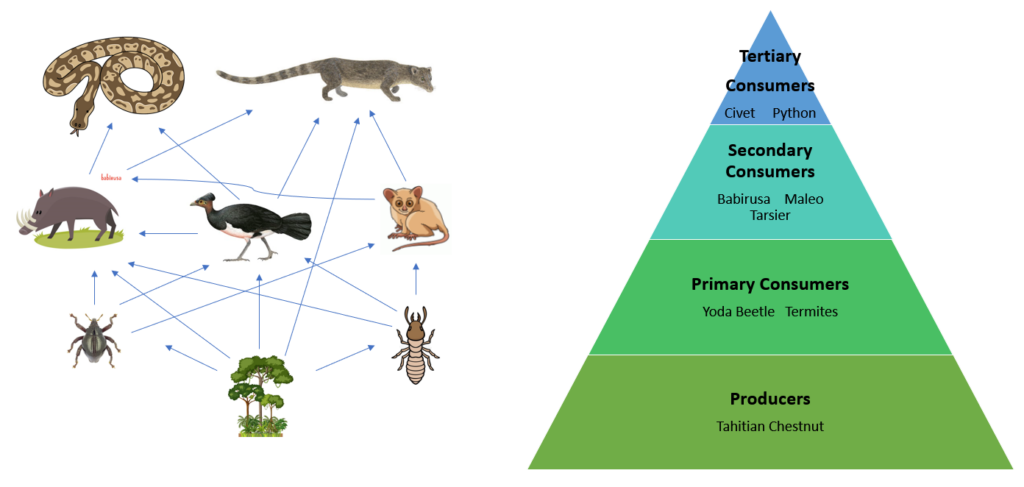Nickel Mining and Sulawesi’s Dwindling Rainforests
ByIndonesia is the world’s largest producer of nickel, and the most productive nickel mine in Indonesia is Sorowako Mine in South Sulawesi (GlobalData, 2022). The nickel on Sulawesi is mined in huge open pits that inevitably destroy vast swathes of animal habitat and break up animal populations.

Sulawesi Island is covered with tropical rainforest and has many species of birds and mammals that are endemic to the island. Currently, the most pressing environmental issue on Sulawesi is deforestation due to logging, farming, and mining; over 80% of Sulawesi’s original forest cover has been destroyed (Butler, 2020).

The problem of deforestation is exacerbated by Sulawesi’s unusual shape; it is primarily made of peninsulas. Consequently, deforestation quickly isolates populations and prevents them from traveling to find new habitats and other members of their population. As a result, many species of animal that are endemic to Sulawesi, such as the barbirusa, are endangered.

Sulawesi Snacks
Among the producers on Sulawesi Island are all the rainforest plants and trees that make their own food from the sun’s energy. One example is the Tahitian chestnut, a tropical evergreen that grows about 20m tall (Health Benefits Times, 2021). The leaves, fruit, and wood of the tree are all eaten by the various rainforest animals.
Primary consumers are herbivores, and the rainforests of Sulawesi are teaming with herbivorous insects. Among these critters is a newly discovered shiny green beetled named Yoda (Trigonopterus yoda). Yoda, an herbivore, is a species of flightless weevil that lives among the leaf litter of the Sulawesi rainforests (Briggs, 2019). There is also a plethora of termites, small, soft-bodied insects, munching their way through the wood and leaves of the Sulawesi rainforest.

The secondary consumers enjoy making a meal of the primary consumers. Among the secondary consumers on Sulawesi is the spectral tarsier is a small nocturnal primate that eats only insects, making it a secondary consumer (Encyclopædia Britannica, 2023). The tarsiers collect the insects from the ground, the air, tree branches, and leaves. Another secondary consumer is the Maleo bird. The Maleo bird is endemic to Sulawesi. This unusual bird is about twice the size of a chicken, lays huge eggs that are 5 times the size of chicken eggs, and can fly but prefers to walk (Critter Man, 2022). The Maleo bird is omnivorous and eats a variety of insects, fruits, seeds, and mollusks.
The apex predators and tertiary consumers in the Sulawesi rainforests are the python and the civet. The Sulawesi palm civet grows to about 80-90cm in head-body length and 60-65cm in tail length (Baker, 2023). It is arboreal, nocturnal, and omnivorous. It will consume a variety of palm fruits and prey on birds, rodents, and juvenile babirusa. The reticulated python is the world’s largest snake and a non-venomous constrictor. On Sulawesi, the pythons are known to consume babirusas, birds, rodents, and even humans on occasion (BBC, 2018).
The Bizarre Babirusa and the Deadly Effects of Deforestation
Babirusas, also known as deer-pig, are omnivorous pigs with two sets of horns (Manansang, 1996). They are secondary consumers that will eat almost anything: fruits, berries, bark, insects, fish, birds, and small mammals. Their only natural predators are reticulated pythons and civets; although these predators, particularly the civets, are more likely to prey on the juvenile babirusa than the more fearsome looking adults.
As deforestation continues, the rainforest habitat of the babirusa continues to disappear, and the carrying capacity of the island is diminished. Furthermore, the babirusas’ habitat is now more accessible to poachers, who act as an additional limiting factor. Often, poachers are not even attempting to catch the babirusas; rather, the traps are being set for the Sulawesi Warty Pig (White Oak, 2020). However, the basic snare traps do not differentiate between the two creatures. Finally, with the babirusa herds are now cut off from each other, there is no opportunity to interbreed. This is unhealthy for the long-term survival of this unique species. The babirusa is currently listed as vulnerable on the International Union for Conservation of Nature Red List (IUCN Wild Pig Specialist Group, 2023).
References
Amazing Sulawesi. (2013, March 25). About the island Sulawesi in Indonesia. Amazing Sulawesi. Retrieved April 2, 2023, from https://www.amazingsulawesi.com/about-the-island-sulawesi
Baker, N. (2023). Sulawesi Palm Civet. Sulawesi palm civet – macrogalidia musschenbroekii. Retrieved March 25, 2023, from https://www.ecologyasia.com/verts/mammals/sulawesi-palm-civet.htm
BBC. (2018, June 18). How a giant python swallowed an Indonesian woman. BBC News. Retrieved March 25, 2023, from https://www.bbc.com/news/world-asia-39427462
Briggs, H. (2019, March 7). Treasure trove of new insects discovered on Island. BBC News. Retrieved March 25, 2023, from https://www.bbc.com/news/science-environment-47483157
Butler, R. A. (2020, July 16). Sulawesi. Mongabay. Retrieved March 25, 2023, from https://rainforests.mongabay.com/sulawesi
Critter Man. (2022, February 2). The Peculiar Maleo Bird. Critter Science. Retrieved March 25, 2023, from https://critter.science/the-peculiar-maleo-bird
Encyclopædia Britannica. (2023, March 6). Tarsier. Encyclopædia Britannica. Retrieved March 25, 2023, from https://www.britannica.com/animal/tarsier#ref891724
GlobalData. (2022, July). Indonesia: Five largest nickel mines in 2021. GlobalData. Retrieved March 25, 2023, from https://www.globaldata.com/data-insights/mining/indonesia–five-largest-nickel-mines-in-2090720
Health Benefits Times. (2021, January 13). Tahitian chestnut facts and health benefits. Health Benefits | Health Benefits of foods and drinks. Retrieved March 28, 2023, from https://www.healthbenefitstimes.com/tahitian-chestnuts
IUCN Wild Pig Specialist Group. (2023). Sulawesi babirusa (detailed profile). WPSG. Retrieved March 27, 2023, from https://www.iucn-wpsg.org/sulawesi-babirusa-detailed
Manansang, J. (1996, July). Babirusa: Population and Habitat Viability Assessment. Retrieved March 25, 2023, from http://www.cbsg.org/sites/cbsg.org/files/documents/Babirusa%20PHVA.7.0.pdf
Supriatna, J. (2023, March 8). Deforestation on Indonesian island of Sulawesi destroys habitat of endemic primates. The Conversation. Retrieved March 27, 2023, from https://theconversation.com/deforestation-on-indonesian-island-of-sulawesi-destroys-habitat-of-endemic-primates-147189
Vale. (2020, May). PT Mega Capital Sekuritas. Retrieved March 25, 2023, from https://megasekuritas.id/
White Oak. (2020, September 8). Babirusa. White Oak Conservation. Retrieved March 27, 2023, from https://www.whiteoakwildlife.org/wildlife/babirusa